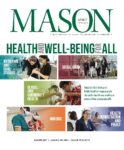Members of Mason’s Engineering Students Without Borders (ESWB) group aren’t waiting until they graduate to put what they’ve learned to use in the real world. Last June, a group traveled to San Isidro, Peru, to implement a water storage system for an irrigation network in a small 100-person agricultural community in the Andes mountains.
“Our ESWB program exposes students to issues and problems that are being faced internationally,” says faculty adviser Barry Liner. “Most important, by putting their academic learning into practice, students participate in hands-on engineering experiences in countries all over the world.”
This particular team of students was led by ESWB president and engineering student Sean O’Bannon, while several local engineering alumni offered their services as mentors. When the project planning and design were complete, the group went to work fund raising, eventually bringing in more than $15,000 for building materials and trip expenses.

Civil and infrastructure engineering alumni Trevor Hughes, BS ’11; senior Sean O’Bannon; John Guenther, BS ’11; Katty Overcash, BS ’05; and Joanna Vivanco, MS ’07, are pictured with one of the storage tanks. Standing in the shade are faculty advisor Barry Liner and Jim Milliken, BS ’11 (on the ladder).
“When we arrived, we were overwhelmed by the response from the community,” says Jim Milliken, BS Civil Engineering ’11. “Some of them didn’t have running water and couldn’t care for their farmlands. You could tell right away how much they appreciated our help.”
For the next two weeks, the ESWB team worked with the community to demolish and dispose of the previous damaged vessel. Then, two new 500-pound tanks were hoisted up the side of a mountain and connected to the existing water system. The water held in the tanks, which is from a nearby natural spring, will be used during the day for farming and drinking.
“The experiences one receives from being a part of ESWB can’t be taught in a classroom,” says O’Bannon. “In real life, things go wrong; the plan doesn’t always go the way it was envisioned. Being able to adapt to your surroundings and fix things on the fly is what separates a true engineer from an academic.”


No Comments Yet »
Leave a comment